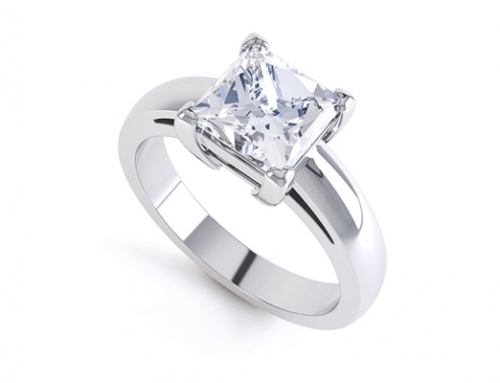You’re out shopping for that beautiful piece of diamond jewellery – a ring, studs, pendant, for that special occasion. It is easy to feel overwhelmed with jargon of the 4Cs of a diamond – carat weight, clarity, colour and cut. How do you cut through the sales pitch and technical jargon to select a beautiful diamond?
What are the 4Cs of a diamond?
Across the world, there is a uniformly accepted system of grading a diamond – what is called the ‘4Cs’ – being carat weight, clarity, colour and cut. Carat weight and cut are influenced by humans whereas, colour and clarity come inbuilt within the rough diamond which is cut into the polished stone.
Carat weight
As the term implies, ‘carat weight’ defines the weight of the diamond. Not its size or measurement. 5 carats = 1 gram. 90% of the world’s diamonds are cut for weight, not beauty! A well cut 1 carat Round Brilliant Cut diamond should measure more than 6.4mm in diameter. But the vast majority of 1 carat stones will be less than 6.3mm. Why? This is because consumers crave the ‘magic weights’ 1 carat, 2 carat, and so on. Hence, to satisfy consumer demand, diamond cutters will cut for weight not sparkle. Doubling weight, quadruples price.
Diamond clarity
After carat weight, diamond clarity has the next biggest impact on price. Clarity refers to the lack of naturally occurring inclusions within (or on the surface) of a diamond. The higher the clarity, the fewer the inclusions (to the maximum level of being ‘internally flawless’), the more expensive the diamond. The biggest mistake that consumers make is to believe that a higher clarity means that the diamond will sparkle more.
The SI2 clarity grade is meant to be the ‘eye clean’ borderline for someone with ‘normal’ vision from about 35cms. Some (especially young) people will spot inclusions in a VS2 clarity graded diamond. Your eyesight, the size of the diamond and the type of inclusions are all determining variables.
Click here to view clarity charts.
Diamond colour
Diamond colour is actually measuring the ‘lack’ of colour in a diamond. The more ‘colourless’ the diamond, the more expensive it is. But, the measurement of diamond colour is done from the back of the diamond. The colour you see from the front of the diamond is influenced by the cut grade, shape and size of the diamond.
To most people, including professional jewellers, you cannot tell the difference between a D, E or F colour. So, D – H colours are good colourless grades. But for larger stones (2 carat and above) or fancy shape stones, D – F colours are the best.
Just as in clarity, consumers make the mistake of believing that a higher colour means more sparkle. That is a myth. I have seen H colour diamonds that sparkle more than an F colour diamond. Because the difference between them is the cut grade of the stone. Colour and clarity add value to the diamond. Not sparkle.
The smart consumers, will purchase blue fluorescent diamonds because they are whiter and brighter and they are cheaper.
Click here to view colour charts.
Diamond cut
I have written a full article on diamond cut grade. For me, it is perhaps the most under-estimated part of the 4Cs of diamond grading, yet, the most important. The manner in which a diamond is cut is all too crucial to how much light it reflects and refracts which is what creates sparkle.
You cannot get a full understanding of the 4Cs of a diamond by DIY online. You have to consult an expert professional jeweller and view some diamonds to appreciate it.
Diamond fluorescence
This is where a diamond emits a blue glow under ultra violet light (as in a nightclub). The grades are faint, medium, strong and very strong fluorescence. Blue fluorescence is the most common because it is the complimentary colour to yellow which is the common tint of a diamond. Take away the yellow and the diamond will give an icy or blue-white appearance. And hence, they look brighter than their actual graded colour. But some fluorescent diamonds look milky and hazy as well in normal light. The trade discounts these diamonds because they are harder to sell. The fact is, it needs hard work to select the right fluro diamonds (ones that are not milky or hazy), and a jeweller needs to train their staff accordingly as well. Too much work and time for a stone that is already discounted by the trade.
I believe that if one educates the customer by showing them such diamonds they will see how the icy or bluish-white colour make them look whiter and brighter than their actual colour grade. And the customer gets a cheaper diamond!
In rare cases, a diamond will fluoresce in a yellow colour or white. The yellow colour fluorescence will enhance the beauty of a yellow diamond but will make near-colourless diamonds look more tinted than their actual grade. White fluorescence is to be avoided. It makes the diamond look milky.
Colour and clarity in different diamond shapes
The shape of a diamond will also influence what colour and clarity grades you will select.
Shapes such as a Round Brilliant, Radiant Cut and Cushion cut have criss-cross facets when you view from the top of the diamond. These facet structures will emit a rainbow of colours when you tilt the stone slightly from side to side what is referred to as ‘fire and brilliance’ of the stone. Owing to this, one could easily select say, a G – H colour and an SI clarity and still get a beautifully sparkly stone.
Step cut diamond shapes such as Emerald cut, Asscher cut and a Baguette cut; and the unique ‘X’ shape facets of a Princess cut mean that one can easily view through the diamond to the very bottom. These have an under-stated but very elegant brilliance. And owing to this, one needs to choose the higher colour grades such as D – F and VS or higher clarity grades.
Cultural differences
Cultural differences between East and West have a big influence on consumer choices of diamond colour and clarity.
Most in the West will believe ‘if you cannot see it then it is fine’. And hence, a lower colour or clarity grade is acceptable as long as the eyes cannot visually spot differences in colour and clarity.
However, many Eastern cultures believe in choosing higher colour and clarity grades such as a D colour and VS or higher clarity grade because it is a symbol of purity. And therefore, they are willing to pay premium prices for these diamonds.
Diamond certification
But sadly, regardless of cultural differences, most consumers base their buying decisions solely on the basis of comparing diamond certificates as opposed to the actual diamond. This has made the industry cut diamonds to achieve certificate grades at the expense of beauty and sparkle.
While I have seen diamonds graded very poorly on their certificates and there are some diamond certifying bodies I would rely upon more than others; it does not mean that all diamond certificates are deceptive.
All the more reason, one needs to see different diamonds, understand their differences and make decisions based on the visual. The golden rule I tell my clients – trust your eyes. They cannot lie. See different diamonds because at the end of the day, you will be wearing the diamond not its certificate. The diamond certificate is merely an authenticity tool that should confirm the technical information provided about the specific diamond by the jeweller.
Every set of eyes are different. What I see as a beautiful diamond will be different to what you see as beautiful in a diamond and will be different to what anyone else will see as beautiful in the diamond.
What if you are buying a diamond to a budget?
So, if you are shopping around for a diamond, chances are that you have a certain budget. And you cannot decide what is it that you should go for. Colour or Clarity?
I hope you can draw on some of the tips I have given in the space of this article. To summarise some of the options you have:
- Choose colour over clarity: Go for the visual and select a whiter diamond and a lower grade of clarity. Because, if you cannot spot any flaws in the diamond, then why pay for a higher clarity?
- Choose a medium – strong graded fluorescent diamond that is not looking milky or hazy in normal light. It will make the diamond look brighter than its actual colour grade and will save you money.
- Consult an expert jeweller who can show you a diamond which has medium level colour and clarity grades but is beautifully cut so that it actually looks bigger than it actually is and sparkles more. (Remember, most Round Brilliant diamonds should be 6.4mm or more in diameter but in actual fact are commonly cut up to 6.3mm – diamonds are commonly cut for weight not beauty).
- Most importantly, trust your eyes! See, compare and decide. Do not base your decision on comparing diamond certificates.
And at the end of the process, ensure that you get a valuation from an independent valuer for insurance purposes as well. Then enjoy wearing your diamond and show it off.








